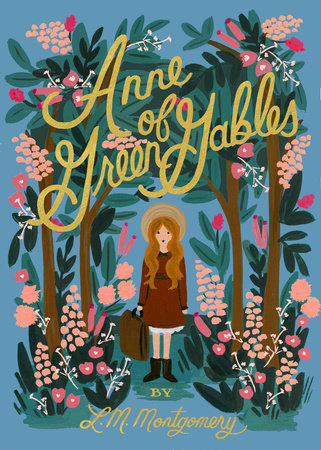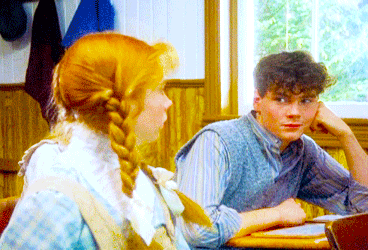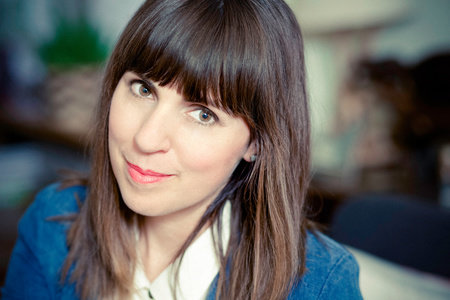I'm sure you all saw my review of Ana of California last week. I absolutely adored this modern retelling of Anne of Green Gables. I felt like it perfectly captured the spirit of the original story while bringing Anne Shirley into the 21st Century. But even if you aren't a fan of Anne of Green Gables you will appreciate this coming-of-age story full of heart with endearing characters and an interesting setting. If you missed my review you can check it out HERE.
Ana of California is out in the world today and to celebrate I have a special interview with the author Andi Teran.
About the Author:
Andi Teran is a writer and performer originally from the deserts of West Texas. She has written about fashion, film, and culture for Vanity Fair, MTV, New York, and Monocle, as well as written and performed for various New York stages. She lives in Los Angeles. Ana of California is her first novel.
You are obviously a fan of
L.M. Montgomery’s Anne of Green Gables.
What made you want to reimagine that story in a modern way?
 |
| Keep reading to win this copy of Anne of Green Gables |
I wanted to reimagine the story in a modern way because a
character similar to Anne felt like something we needed more of in our current
culture. I’m a huge fan of outspoken heroines who aren’t born with the greatest
of luck in life but choose to find a way to better their situations for
themselves. I always want to root for the go-getters and self-starters; those
who are told no but choose to live their lives as a gigantic yes.
When I sat down with what I envisioned to be today’s Anne—aka Ana—she
immediately spoke to me on the page. She was older than the precocious,
11-year-old Anne, and she had languished within the foster system longer. I
immediately related to her spirit, which was much different from the original
Anne. She was more street savvy and subdued, as if her imagination and
outspokenness had been progressively silenced and driven deeper into her over
time.
The characters of Abbie and Emmett, the counterparts to Marilla
and Matthew, came out much differently than I expected too. They were much more
self-aware about their situation on the farm and truly struggling—like many
small farmers today. It was important to me to highlight that while also
creating a nontraditional family unit. The rest of the characters just
appeared, quite naturally, and sometimes shared attributes with the originals,
but were mostly born from my own imagination. To be honest, I couldn’t stop
writing. It was so much fun to enter this whole new world that came from a
place that felt so beloved and familiar even if it was often at the back of my
mind.
Ana of California is your first novel, but
you’ve had a robust career as a nonfiction writer and performer. Have you
wanted to write fiction for a long time? Do you have plans to write more
novels?
I’ve always wanted to write fiction. I’ve been writing it in
secret for most of my life! I wrote short stories and plays growing up but wanted
be an actor, so I concentrated on that. Any time I played a character, though,
I’d write vast background histories about them or keep a journal. I eventually moved
to New York City and sort of fell into magazine writing while also working as a
hotel concierge and performing in plays at night. The office of a local culture
magazine was next door to the hotel, and I got to know the publisher. He was
the first person to ever give me an assignment, which led to more regular
reporting. It was tough juggling it all, but I wanted to do and learn as much
as possible.
As I got better at writing small pieces, I reached out to other
publications. Even though I had no formal training as a writer, I learned so
much from editors who were willing to take a chance on me. The feedback was
often brutal, but my many failures wound up giving me some success too. I
discovered my strengths, specifically interviewing people and writing
first-person essays, both of which have to do with embodying real-life
characters. I was able to quit my job and write full time, all in the hopes of
one day writing a book.
Interestingly, I’ve found that fiction writing is a lot like
theatre. You get to play all the characters while also writing and directing
them, which is thrilling to me. Thus, to answer your question, yes I have plans
to write more novels… many more hopefully!
The location of the novel is
so important – Ana goes from inner-city Los Angeles to a community farm near
the ocean, and you evoke the change in landscape so well. What inspired you to
set the novel in California?
 |
| Check out this hand drawn map of Hadley that Andi did! |
I’m a recent transplant to California. Much like Ana, I was
familiar with parts of Los Angeles, but had never explored the beaches or
remote forests in the most northern part of the state. I grew up in Texas, and
spent over a decade in New York, but the West Coast always intrigued me. My
mother’s side of the family is originally from the Bay Area, so I’ve traveled
there and to the southern part of the state throughout my life. Coming here has
always been a joy. I’m still enchanted by the diversity of people and terrain.
It’s a wildly spectacular part of the country.
The city of Los Angeles called to me initially. It’s such a
vibrant metropolis interwoven with nature. I find it crazy that I can encounter
a coyote on a mountain hike, have coffee in a forest café afterwards, and then
go for ramen downtown in Little Tokyo or for tacos like my grandma used to make
out in Boyle Heights. Both downtown and the communities in East L.A. appeal to
me particularly. You can always find pockets of magic if you’re willing to look
for them. I knew immediately that this is where Ana was from.
Within the first few months of living here, I was eager to explore
other parts of the state. My husband, sister-in-law, and I decided to take a
road trip from L.A. all the way up to the dense forests surrounding California’s
Lost Coast, which is a remote stretch of coastline that borders the mountains
and lush forests surrounding Humboldt County. We were blown away by what we
found. Aside from the quaint towns dotted with Victorian houses, there was this
uninhabited coast with jagged cliffs as far as you could see. It was lonely,
beautiful, and felt like a forgotten part of the world. We got lost amongst the
towering redwoods and ate meals made from fresh, local produce along the way. Interesting
characters populated every place we visited. With Ana already in my mind, I
knew this is where she needed to go.
Your main character, Ana,
joins the ranks of Famous Literary Orphans. In her short life, Ana has faced
gang violence, emotional abuse, and racism. Did you want to draw attention to
these larger social issues with your novel, or were you thinking more of
creating a realistic, complex character?
The answer is a bit of both. It was impossible not to write
someone who was realistic and complex when I wanted her to be directly impacted
by current social issues. We’re living in a changing time that I can’t believe
is still rife with racism, sexism, and emotional abuse. We hear about it in the
news or on the Internet daily, whether we’re the recipients or witnesses
thereof. Gang violence is still very real in this country too, not to mention rampant
south of the border. It’s part of Los Angeles’s history.
It was important that not only Ana, but also all of the characters
be people readers can relate to in a realistic way. Ana was the emotional core,
so everything sprang from her, including the shadows of her past and how she
chose to deal with them. I worked with at-risk children and runaways when I
lived in Texas, and I encountered a few who came from gang or drug connected
families. Though I never knew their stories, I was deeply affected by the
destruction it seemed to cause in such young, undeveloped hearts and minds.
Their situations seemed hopeless, even more so when few adults seemed to truly
care. I always wondered what became of them. Ana was a way for me to imagine
their collective strength in a single soul, and that maybe with a strong spirit
and bit of hope, there could eventually be a way out.
The modern farming movement,
especially small, organic farms, is highlighted in Ana of California. What made you want to include this in your
novel? How did you research the industry?
Moving to California drastically changed my diet. There’s such an
abundance of fresh fruit and vegetables grown mindfully and locally here. I
started going to farmer’s markets on weekends and wanted to learn more about
where my food came from. What struck me most was the friendliness of the
farmers. They’d often talk to their customers, educate them, and keep them
coming back whether they were local chefs buying in bulk or the average home
cook. I liked that part of their job included engaging with their local
community.
When thinking about Abbie and Emmett, it was clear to me that they
were these types of farmers. I read everything I could about California organic
farms and the increasing takeover of the little guy by corporate behemoths that
favor genetically modified seeds and crops. I enjoyed learning about people who
were going back to the land to make a difference for their families and communities
in the healthiest way possible. I think we need so much more of this.
I also researched migrant farm workers and the difficulties they
face. Manny was one of the first characters that jumped onto the page. He told
me to dig deeper, so I did, and I was horrified by much of what I found. These
are people doing tremendously difficult work for very little money, housing, or
hope of escape. They are the backbone of our food industry and are often
treated unfairly and inhumanely. It’s not always the case, of course, but a
quick Google search will unearth endless articles about their plight. Honestly,
I wish I could have written more about Manny and the other workers on Garber
Farm. This is a subject worthy of more widespread attention.
I visited a few organic farms and even worked at one picking and
harvesting a variety of crops. I was humbled by the hard work—always beginning
at the crack of dawn—and by the people I met whose devotion to the earth was
beyond inspiring. There’s nothing like putting your hands into the ground and
pulling out something that has been carefully grown and looked after solely for
the purpose of nourishing you. I met other volunteer farm hands who live simply
but mindfully. We all ate lunch together made from the farm’s offerings and
listened to stories told by the head farmer. Creating the world of Garber Farm
was a way of extending this somewhat utopian experience and, hopefully, making
others aware of how important it is that we support these types of farms and
their workers.
Readers will recognize
characters from Anne of Green Gables transposed
into your story. Emmett and Abbie, for example, are Ana of California’s versions of Matthew and Marilla. Were you
daunted in tackling these classic characters? Was it fun thinking about where
they would be in a modern setting?
I was extremely daunted about tackling these characters. There’s
no way I can come even close to the magic wrought by L.M. Montgomery, but I
wanted this to be a standalone book separate from that legacy. I wanted to
honor the original in the best ways that I could while also following my own
instincts and imagination to create something wholly new. Ultimately, I want readers
to enjoy the twists on the original but also see Ana of California as its own story.
Though I knew who Ana was from the start, it took me a while to bring
her to life. I didn’t know her full story until I finished my first draft, and
she ended up being much different from what I’d initially imagined. It was hard
not to think about Anne while I was writing and whether or not I was doing her
memory justice. I had to remind myself that Ana was a completely different
person shaped by her own unique experience.
Abbie ended up being my momentum throughout that first draft. She
was nothing like Marilla, and this felt so right. I realized quickly that Abbie
was much more like Matthew, and Emmett was more of a Marilla, so flipping these
personalities became a joy to write. I purposefully made Abbie and Emmett
younger than their counterparts too. It humored me to think that Marilla
Cuthbert might have had a scandalous streak during her teenage years, and that
idea worked so well for Abbie. As for Emmett Garber and his relation to Matthew
Cuthbert—easily one of my favorite characters in the original—I just couldn’t
see them as being remotely the same. Emmett was curmudgeonly from the start and
wary of Ana, but that also made him subject to great change simply through her
presence on the farm.
 |
| Source |
Creating Cole Brannan was probably the closest I came to there
being a direct correlation to an original character, namely Gilbert Blythe. It
was important for Ana and Cole, like Anne and Gilbert, to spar with each other
intellectually and be equals. I wanted them to challenge each other. I loved
Gilbert’s self-confidence and daring, so I translated that physically for Cole
through his love of motocross. Fans of the original will note that there is not
a “breaking the slate” scene, but I do hope they find other less obvious
similarities.
As for Rye Moon, all I can say is I love her. She, like Emmett,
was such a surprise and, other than her loyalty, was the complete opposite of
her original counterpart, Diana Barry. I wanted her to be more aloof at first,
and someone eager to get out of her small town and see the wider world. Just as
Ana and Cole were equals, I wanted the same for Ana and Rye too. In deference
to the breaking the slate omission, I hope readers will enjoy a more subtle
translation of “bosom friends.” I couldn’t leave out that reference.
Literature, particularly for
young adults and children, has a dearth of non-white main characters. What are
your thoughts on this issue? Is that something you consciously wanted to
address with Ana Cortez?
Absolutely. I think we need more diversity across all artistic
mediums, period. We are a diverse culture, after all, and it’s odd to me that
more of us aren’t presented with subject matter than we can relate to. I also
think it’s important to be interested in and exposed to cultures that are
different from our own.
I grew up in a mixed race, Mexican American family. People rarely
thought I was “traditionally Mexican,” whatever that means. I grew up in El
Paso, Texas, on the border of Mexico, and I had friends and family from both
sides of the bridge. This was normal to all of us. I spent a good portion of my
childhood with my Mexican grandma who cooked traditional meals, told stories
about our ancestors, and often took us grandchildren across the border. That
heritage was ingrained in me from an early age. Thus, it was important to
infuse that into Ana too, as she, like me, would understand the same tastes,
smells, and heritage that I grew up with. I hope others can relate to or be
interested in it too.
I think it’s imperative that we have more sexual, racial, and
cultural diversity in art and literature. How else will we truthfully chronicle
modern life?
And that's exactly what Ana of California has done. Seriously, I'm so excited for this book to be out in the world and for everyone to get a chance to read it. Whether you are a fan of Anne of Green Gables or not, this book is worth your time. I believe that so much that I have a special giveaway to share the love. The fantastic folks at Penguin will be giving away one copy of Ana of California and this beautiful edition of Anne of Green Gables. So whether you want to fall in love with Avonlea for the first time or fall in love with it all over again, now is your chance. All you have to do is enter the rafflecopter below. Sorry international friends, this is US only.


I love retellings , almost all of my favorite books are retellings so I'm familiar with them.
ReplyDeleteThey&doubledayis book has been getting raves.
ReplyDeleteLove Retellings!
ReplyDeleteI love retellings b/c its great to see a story told in many different ways. thank you!
ReplyDeleteWhat a great interview, I really enjoyed learning more about the author. I read and reread the Anne books, some of my cherished memories of being a kid! Thanks so much.
ReplyDeleteI've never read Anne of Green Gables, but I do enjoy retellings. It is always nice to view a story from a different angle.
ReplyDelete